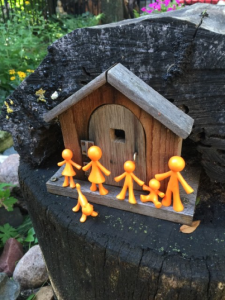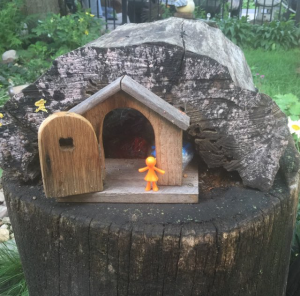Fairy House Families

After attending a math workshop (Do we want to admit this was a Math At Home training?), I received a container of what I would normally call, “Counting Bears.” I generally do not like these so called counting “manipulatives.” They tend to be bears, in primary colors and they are used for counting, sorting by color, patterning and other math related ideas. As much as I don’t like them, my students love to play with these. They are small and fit in little hands, and they just gravitate to them. We have removed all of the branded play characters in our program, so small animals and people are needed for imaginary play. There was something different about these counters. Instead of bears, they were people. Families!  Each colored set contained a tall man and woman, small boys and girls, a baby and a cat, all of one color. We all wish there was a dog, but a cat it was. I love these people. I also knew my students would love these! We are always looking for people to add to our loose parts play. I also loved that children could create a family to look like theirs. If they have a grandmother living with them, or stepparents or same sex parents, the child could make a family that looked like theirs. I knew these “people” would be a hit!
Each colored set contained a tall man and woman, small boys and girls, a baby and a cat, all of one color. We all wish there was a dog, but a cat it was. I love these people. I also knew my students would love these! We are always looking for people to add to our loose parts play. I also loved that children could create a family to look like theirs. If they have a grandmother living with them, or stepparents or same sex parents, the child could make a family that looked like theirs. I knew these “people” would be a hit!
This is where it gets tricky. How should I add these to our play so that they are used intentionally? How many is too many? In my past teaching days, I would have dumped the container into a basket and added it to our block area. Sorting by color, size and gender would have commenced. Soon there would be 72 “people” in every corner of our classroom. It’s too, too many! We have six to eight students in our class. When we add too much of a good thing, it loses it’s value and respect.
At about this same time, I realized I needed a new treasure from our trusted fairy. I never thought I would jump into the whole fairy garden fad…but the children love it. We have a fairy house in our outdoor classroom where the children leave drawings or notes for our fairy that responds with small tokens of magic. Our fairy house is a simple old log that was hollow, where we added a door. This crazy little fairy hut has become a literacy and math hub for our program. I strongly encourage you to find a corner of your yard or home and repurpose an old farm or dollhouse, or even an old birdcage for your own fairy house.  The fairy brings shiny buttons, mini pinecones, acorns, and other surprises to our days. These families would be perfect for our fairy house surprises! I decided to wrap a family up for each of the children in our program.
The fairy brings shiny buttons, mini pinecones, acorns, and other surprises to our days. These families would be perfect for our fairy house surprises! I decided to wrap a family up for each of the children in our program.
As expected these families were an instant success! On a sunny, humid 95-degree day, the children quickly grabbed their tree cookies, found the shady side of the play yard and began creating homes for their families. Neighborhoods were quickly arranged, and the building began!  Where is the math? The math came in sequential ordering, spatial awareness, collecting, comparing attributes, the list goes on and on! Our fairy brought us so many math concepts that were embedded and integral to the children’s play!
Where is the math? The math came in sequential ordering, spatial awareness, collecting, comparing attributes, the list goes on and on! Our fairy brought us so many math concepts that were embedded and integral to the children’s play!
If the counting bears are collecting dust in your closet, or you have too many Hot Wheels or stuffed animals, try reducing the numbers and watch how the play will change. Sometimes 2 + 2= too, too much! Less equals more. Children love to recreate their lives with small animals and figures but if we overwhelm them with too many choices it creates chaos and over stimulates their brain. We did not need 72 new characters in our program. Each child took their “family” home and our fairy left one family here for loose parts play, and gave another teacher the remaining people. Share your goodness with others, because that’s great math!
Very amazing and open ended learning experience for the children to both connect and conclude new and separate endings for their stories. The fairies allowed the subject matter to be related in so many different areas of learning topics and skills. Wonderful addition to the outdoor classroom teaching and learning experience.
Great idea.
I love, love, love this open-ended, rather nature-based concept! I have employed something similar-I have a mud kitchen with various sized pots, pans, measuring cups, and so forth. It’s great for early math!